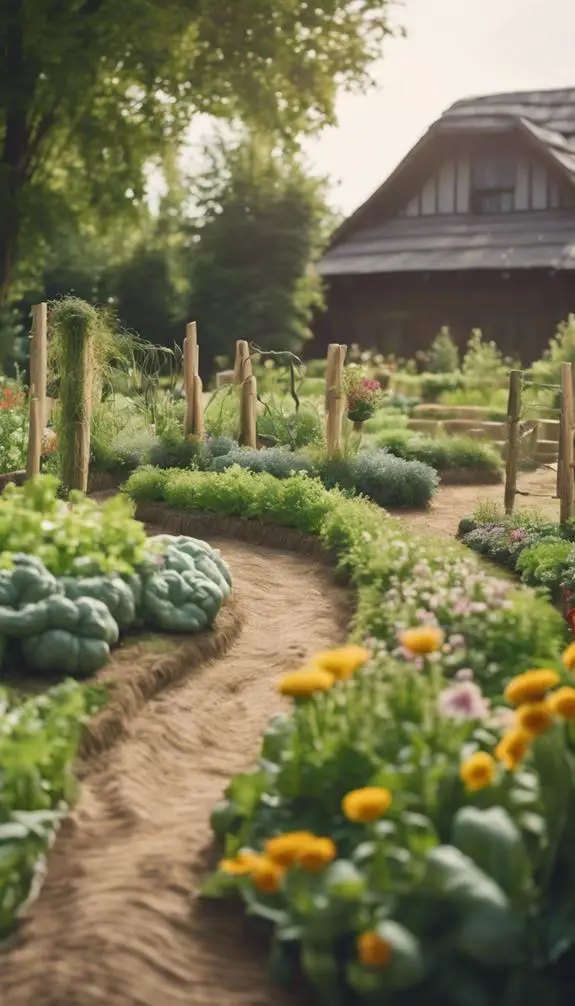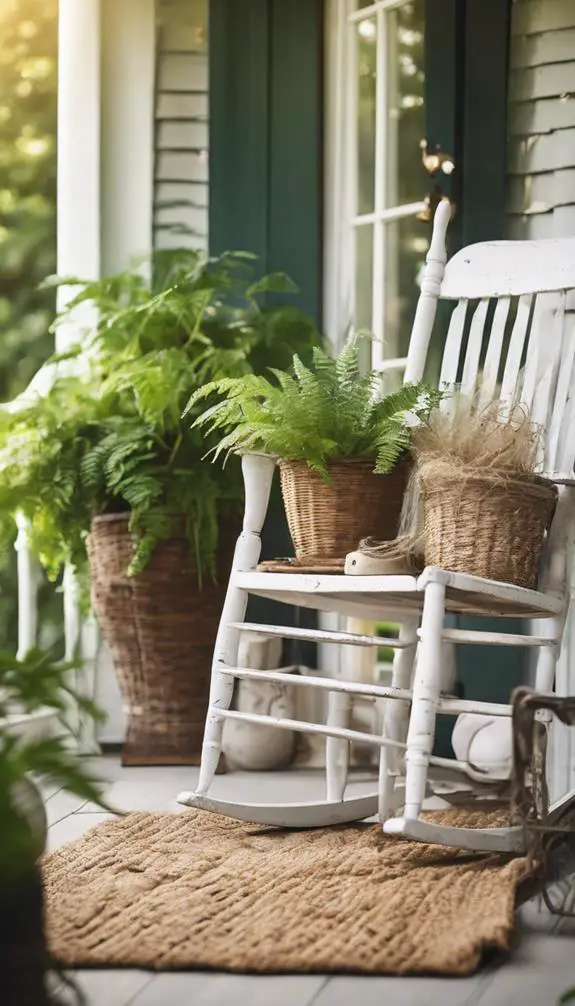As you explore the world of succulents, you may have wondered if growing them from seed is possible. The answer is yes, and it can be a highly rewarding experience. With the right techniques and care, you can cultivate rare and unique succulent species that will thrive under your care. From aloe to echeveria, there are numerous species that can be grown from seed, offering endless possibilities for experimentation and discovery. But where do you start, and what are the secrets to success?
Summary
- Fresh, high-quality seeds from reputable sources increase chances of growing healthy, thriving succulents.
- Sterilize seed starting mix by baking it in the oven to kill fungal spores or bacteria.
- Sow seeds at the correct depth, typically 1-2 mm deep, depending on the species, and water with a fine mist.
- Provide the right amount of light, ideal soil and watering conditions, and maintain an ideal temperature range for optimal growth.
- Fertilize seedlings once a week with a balanced, water-soluble fertilizer at half the recommended strength to avoid burning tender roots.
Choosing the Right Succulent Seeds

Selecting the right succulent seeds is a crucial step in ensuring the success of your succulent-growing journey.
You'll want to focus on seed quality, which can markedly impact germination rates and overall plant health. Look for seeds that are fresh, dry, and free of contaminants.
Reputable seed sources, such as specialty nurseries or online retailers, can provide high-quality seeds. Avoid seeds from unknown or unreliable sources, as they may be old, low-quality, or even counterfeit.
When selecting seeds, check the packaging for information on seed age, storage conditions, and germination rates. By choosing high-quality seeds from trusted sources, you'll set yourself up for success and increase your chances of growing healthy, thriving succulents.
Preparing Seeds for Planting

With your seeds in hand, it's time to prepare them for planting.
First, inspect your seeds for any signs of damage or degradation. Fresh seeds are essential for maximum germination rates, so verify you're using seeds that haven't been stored for too long.
If you've had seeds in storage, check their seed storage conditions – cool, dry places are ideal.
Next, gently clean your seeds to remove any debris or residue. This helps prevent any fungal or bacterial growth that might hinder germination.
Finally, make sure your seeds are completely dry before planting to prevent rotting.
Sowing Seeds in Soil

Now that you've prepared your seeds, you're ready to sow them in soil.
Begin by filling a small pot or cell tray with a well-draining seed starting mix. Sterilize the soil by baking it in the oven at 300°F (150°C) for 30 minutes to kill any fungal spores or bacteria.
Sow the seeds at the correct depth, typically 1-2 mm deep, depending on the species. Cover the seeds with a thin layer of soil. Firm the soil gently to secure the seeds in place.
Water the soil with a fine mist, taking care not to wash away the tiny seeds.
Creating Ideal Growing Conditions

You'll need to provide your succulents with the right amount of light, as some species require direct sunlight while others prefer filtered or indirect light.
You'll also need to guarantee the soil and watering conditions are ideal, as succulents are sensitive to overwatering and require well-draining soil to thrive.
Lighting for Succulents
Beyond the soil and water, lighting plays a crucial role in creating ideal growing conditions for succulents.
You'll want to provide your succulents with adequate natural light, especially during the day. East- or west-facing windows are ideal, as they receive gentle, indirect light. Avoid direct sunlight, which can cause burning.
If natural light is limited, you can supplement with artificial lighting. Fluorescent lights or LED grow lights work well, providing a spectrum of light that promotes healthy growth.
Aim for 12-14 hours of light per day, and adjust as needed based on the specific succulent species. By providing the right amount and type of light, you'll be well on your way to growing thriving, healthy succulents.
Soil and Water Needs
Frequently, succulents are finicky about their soil and water conditions, requiring a delicate balance to thrive.
You'll want to use a well-draining soil mix specifically designed for cacti and succulents. This type of mix will contain a blend of perlite, vermiculite, or sand to prevent waterlogging.
When it comes to watering, you'll need to monitor the pH level, as most succulents prefer a slightly acidic to neutral water pH, ranging from 6.0 to 7.0. Avoid using tap water, which can be alkaline, and instead opt for rainwater or distilled water.
Water your succulents sparingly, allowing the soil to dry out completely between waterings. This will help prevent root rot and guarantee your plants receive the right amount of moisture.
Watering and Humidity Control
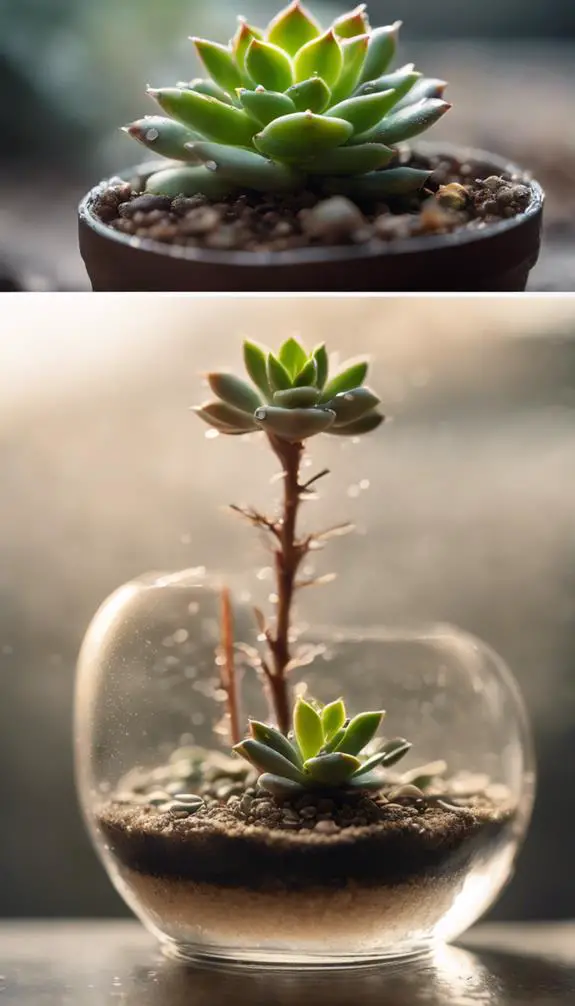
You'll need to develop a watering schedule that takes into account factors like soil type, pot size, and climate to guarantee your succulents receive the right amount of moisture.
To prevent overwatering, it's vital to monitor humidity levels and adjust your watering schedule accordingly.
Watering Schedule Essentials
Most succulent species require a well-planned watering schedule to thrive, as they're adapted to survive in dry conditions with infrequent rainfall.
You'll need to strike a balance between providing enough water for seed germination and preventing waterlogged soil that can lead to root rot.
When you water, make sure the soil is moist but not saturated, as succulents have adapted to absorb water slowly.
Water absorption occurs primarily through the roots, so guarantee the soil has good drainage to prevent water from pooling around the roots.
Aim to water your succulents when the top inch of soil feels dry to the touch, usually every 7-10 days in the spring and summer, and less frequently during the fall and winter.
Humidity Level Management
As you fine-tune your watering schedule, consider the humidity levels surrounding your succulents, as they've a significant impact on their health.
Succulents thrive in dry conditions, but some species require more humidity than others. To create a humid microclimate, you can mist the air around your plants or place them on a tray filled with water and pebbles.
Foggy environments can also promote healthy growth, especially for species like Crassula and Echeveria. Be cautious not to over-humidify, as this can lead to root rot and other issues.
Moisture Meter Readings
Every succulent enthusiast should invest in a reliable moisture meter, a key tool for achieving ideal watering and humidity control.
When it comes to seed germination, accurate moisture readings are essential. You'll want to calibrate your meter regularly to guarantee precise measurements.
For peak results, take readings at the same depth and location each time. Aim for a reading between 1-3 on the moisture scale for most succulent species.
Be cautious not to overwater, as this can lead to rot and poor germination rates. By monitoring moisture levels, you'll be able to fine-tune your watering schedule and create the perfect environment for your seeds to thrive.
With a reliable moisture meter, you'll be well on your way to successful seed germination and healthy succulent growth.
Providing Adequate Light
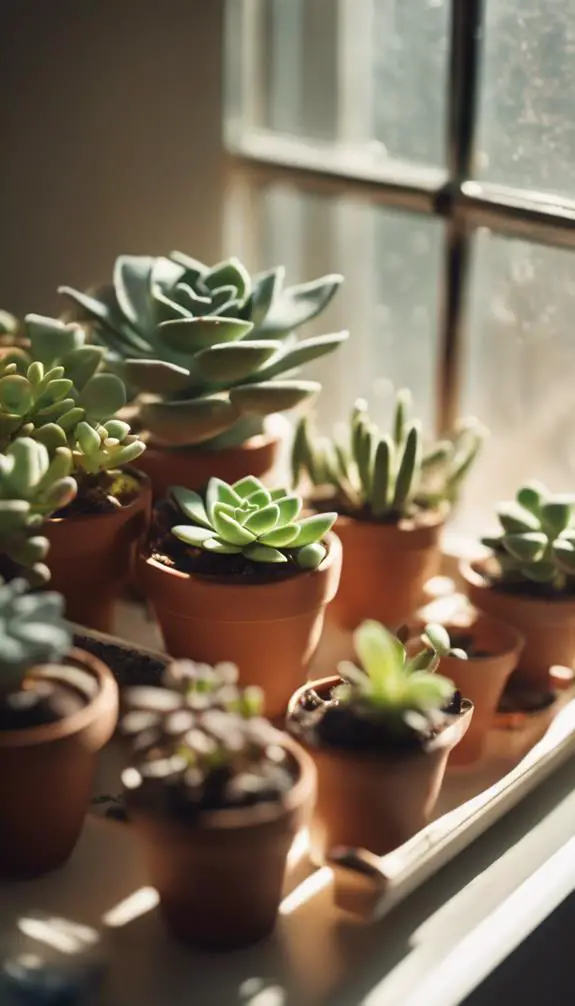
Your succulent's ability to photosynthesize effectively hinges on its exposure to adequate light, which directly impacts its growth rate, color, and overall health.
To provide ideal light conditions, position your succulent near an East window, which receives gentle, indirect light. However, if you want to promote more vigorous growth, consider a South exposure, which receives intense, direct light.
Be cautious not to overexpose your succulent, as this can lead to scorching. Aim for 4-6 hours of direct sunlight or 12-14 hours of indirect sunlight daily.
Monitor your succulent's response and adjust its position accordingly. By providing the right amount of light, you'll be rewarded with a thriving, vibrant succulent.
Maintaining Optimal Temperature

Temperature fluctuations can greatly impact your succulent's health, making it essential to maintain an ideal temperature range.
Most succulent species require daytime temperatures between 65°F to 75°F (18°C to 24°C) and slightly cooler nighttime temperatures. Avoid placing your seedlings near heating or cooling vents, fireplaces, or drafty windows, as this can cause temperature fluctuations.
Some succulent species, like aloe and echeveria, require cold stratification, a period of cold temperatures, to germinate. Verify you research the specific temperature requirements for your succulent species.
Fertilizing Succulent Seedlings
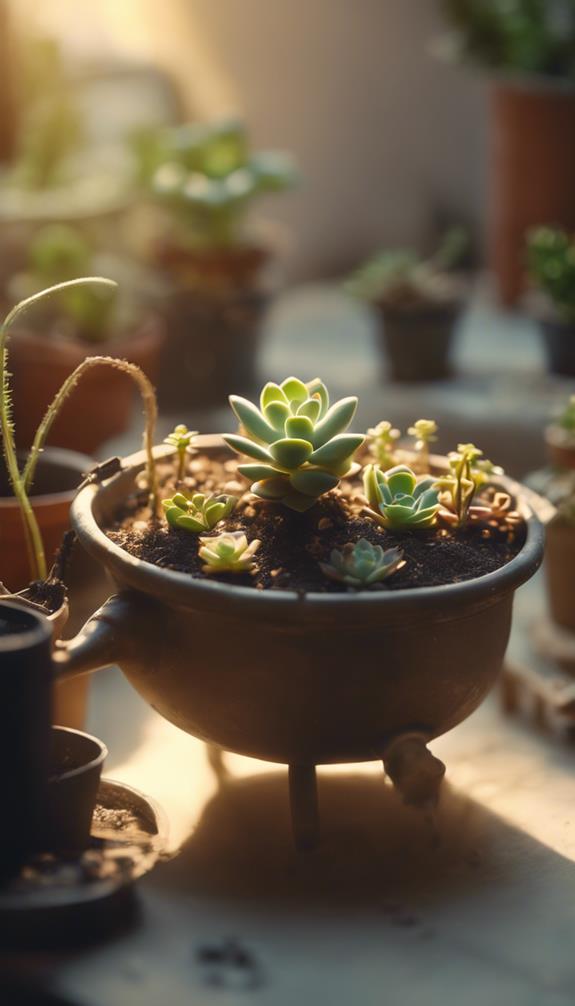
When it comes to fertilizing succulent seedlings, timing is crucial, as feeding them too early can hinder their growth.
You should wait until they've two sets of leaves, usually around 1-2 weeks after seed starting. At this stage, you can start using a balanced, water-soluble fertilizer at half the recommended strength.
Dilute the fertilizer to avoid burning the tender roots. Apply it once a week, making sure the potting mix is moist but not waterlogged. A good potting mix will already contain some nutrients, so avoid over-fertilizing.
Remember to follow the manufacturer's instructions and take into account the specific needs of your succulent species. By fertilizing correctly, you'll give your seedlings the best chance to thrive.
Transplanting Seedlings Outdoors
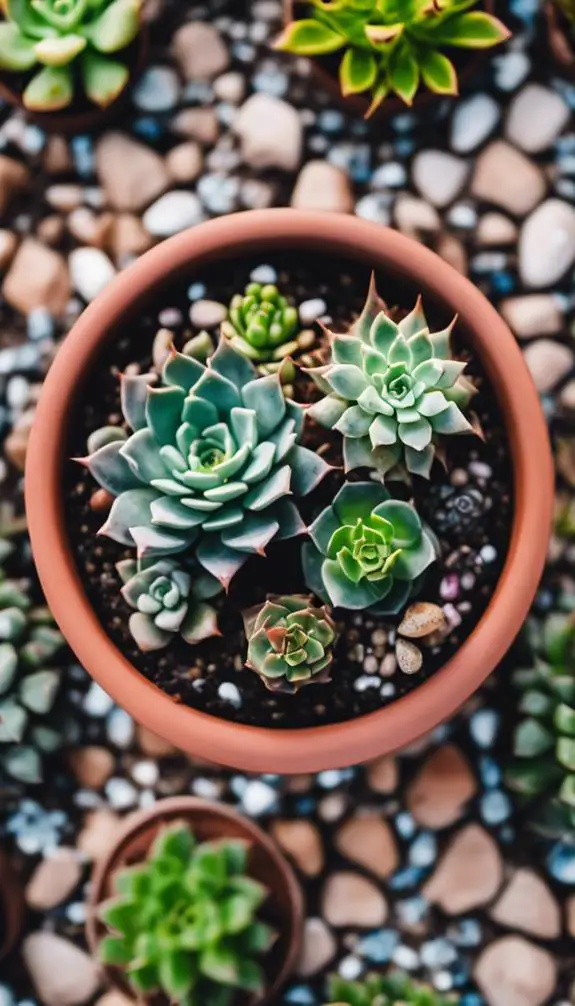
As your seedlings have grown strong and healthy under careful fertilization, it's now time to give them the ultimate gift: a spot in the great outdoors.
Before transplanting, you'll need to acclimate them to outdoor conditions through a process called seedling hardening. Start by moving the seedlings to a shaded outdoor area for 1-2 hours a day, gradually increasing the duration over 7-10 days.
This outdoor acclimation process helps seedlings adjust to direct sunlight, wind, and temperature fluctuations.
Once hardened, choose a location with well-draining soil and full sun to partial shade, depending on the succulent species.
Handle the roots gently during transplanting, and water thoroughly after settling the soil.
With proper care, your seedlings will thrive in their new outdoor environment.
Common Problems to Watch

Monitoring your succulents' health becomes essential once they're transplanted outdoors, as they're more susceptible to pests, diseases, and environmental stressors.
Keep an eye out for signs of overwatering, which can lead to root rot and poor seed germination. Guarantee proper air circulation to prevent fungal diseases.
Inspect your plants regularly for pests like mealybugs, spider mites, and scale.
Store seeds properly in a cool, dry place to maintain their viability. Improper seed storage can reduce germination rates, so it's pivotal to follow proper storage techniques.
Propagating Rare Succulent Species

You're likely drawn to rare succulent species because of their unique shapes, vibrant colors, or striking patterns.
To propagate these rare succulents, you'll need to source high-quality seeds from reputable seed sources. Research online marketplaces, specialty nurseries, and succulent enthusiast communities to find vendors who offer authentic and fresh seeds.
When selecting seeds, look for ones that are specifically labeled as "rare" or "hard-to-find" to guarantee you're getting the unique species you're after. Be prepared to pay a premium for these seeds, as they can be difficult to cultivate and harvest.
With the right seeds and proper care, you'll be able to successfully propagate your rare succulent species and add to your unique collection.
Succulent Seedling Care Tips
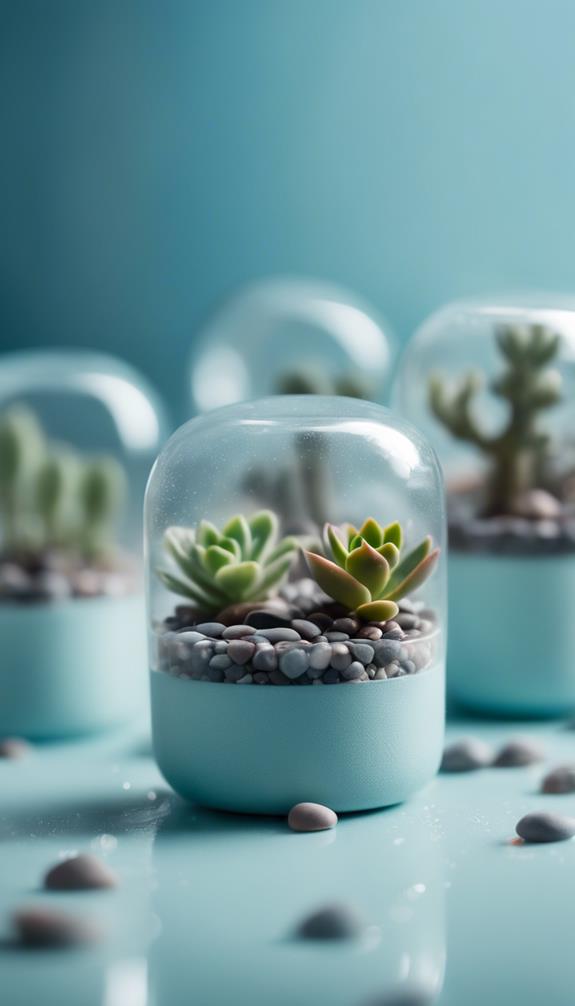
You'll need to provide your succulent seedlings with the right environment to thrive.
This means selecting a well-draining potting mix specifically designed for cacti and succulents, and watering them carefully to avoid root rot.
You'll also need to weigh the lighting and humidity requirements for your seedlings, as these factors can greatly impact their growth and development.
Soil and Watering Needs
Most succulent seedlings require a well-draining potting mix specifically designed for cacti and succulents. You can't use regular potting soil, as it retains too much water and may cause root rot.
Look for soil types that contain ingredients like perlite, vermiculite, or sand, which improve drainage and aeration.
When watering, make sure to water sparingly, as succulent seedlings are prone to overwatering. Check the soil daily, and only water when it feels dry to the touch.
Avoid getting water on the leaves to prevent fungal diseases. Water retention is vital, so guarantee the pot has good drainage holes to prevent waterlogged soil.
Lighting and Humidity
Succulent seedlings require lighting that's both intense and filtered, as direct sunlight can scorch their tender leaves.
You can achieve this by placing them near an east- or west-facing window or using a sheer curtain to diffuse the sun's rays. Morning sun is ideal, as it provides a gentle, warm light that promotes healthy growth.
If you live in a desert climate, be cautious of intense sunlight and provide extra shading.
With regard to humidity, succulent seedlings prefer a relatively low humidity environment, around 40-50%.
You can increase air circulation by keeping them at least 6-8 inches away from each other.
Popular Succulent Varieties
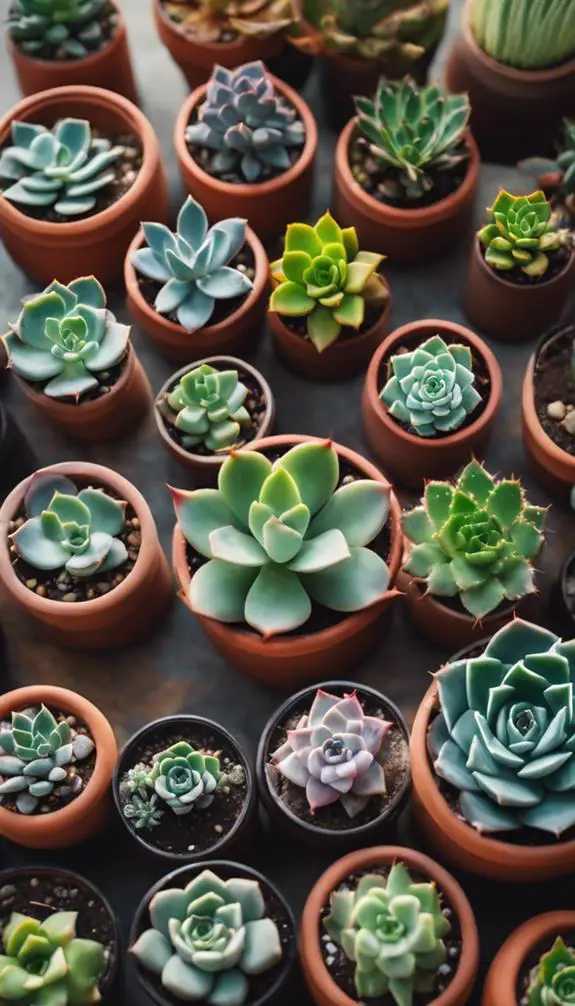
Among the vast array of succulent species, a few popular varieties have emerged as favorites among enthusiasts and beginners alike.
You'll find that succulent trends often revolve around unique shapes, vibrant colors, and low-maintenance care.
Echeveria, Crassula, and Sedum are top contenders, with their striking rosettes and adaptability to indoor conditions.
Hybrid possibilities have also opened up new avenues for succulent breeding, resulting in exotic and intriguing varieties like Aloe-Echeveria hybrids.
When growing succulents from seed, you can experiment with these popular varieties and create your own unique hybrids.
This not only expands the succulent gene pool but also allows you to contribute to the ever-evolving world of succulent trends.
FAQs
Can I Grow Succulents From Seed Indoors Year-Round?
You can successfully grow succulents from seed indoors year-round by optimizing seed starting techniques and indoor conditions, such as providing sufficient light, precise temperature control, and careful watering to stimulate healthy germination and growth.
How Long Do Succulent Seeds Remain Viable for Planting?
You can store seeds for up to 5 years, maintaining their viability, by keeping them cool (around 40°F) and dry, ensuring ideal seed freshness; proper seed storage is key to successful germination, so plan accordingly.
Can I Use Regular Potting Soil for Succulent Seeds?
You'll want to avoid regular potting soil for succulent seeds, as it retains excessive moisture, causing rot; instead, opt for a well-draining mix with a soil composition that guarantees ideal moisture levels, around 20-30% water-holding capacity, for successful germination.
Why Do Succulent Seeds Have Low Germination Rates Sometimes?
You'll often find that seed germination rates are low due to poor seed quality or unfavorable environmental factors, such as inadequate light, temperature fluctuations, or inconsistent moisture, which hinder ideal growth conditions.
Can I Save Seeds From My Existing Succulent Plants?
You can attempt seed harvesting from your existing succulent plants, but be aware that not all succulent varieties produce viable seeds, and some may require specific conditions for successful germination.
Conclusion
You've successfully grown succulents from seed, and now it's time to enjoy the fruits of your labor. With proper care, your seedlings will mature into thriving plants. Monitor their progress, adjusting light, temperature, and watering as needed. Prune and repot to maintain shape and promote healthy growth. By doing so, you'll be rewarded with unique, rare, and stunning succulent species that will continue to captivate and inspire you for years to come.


